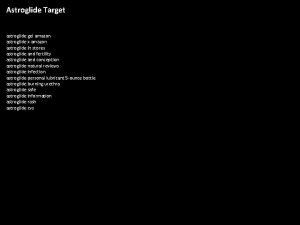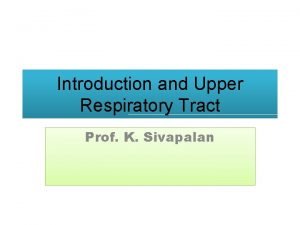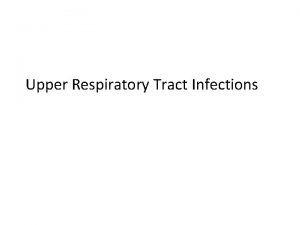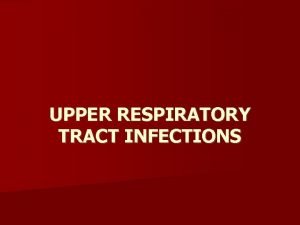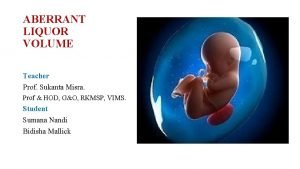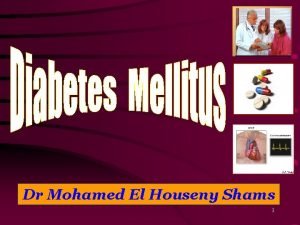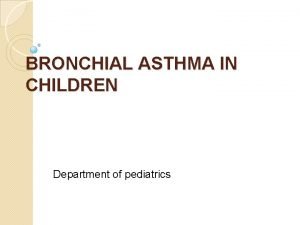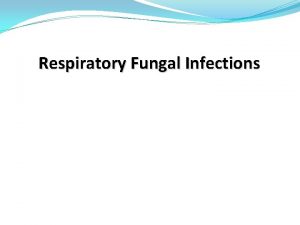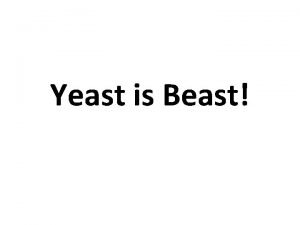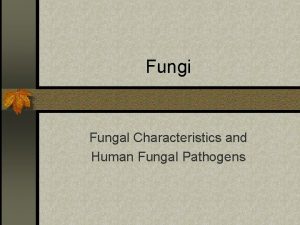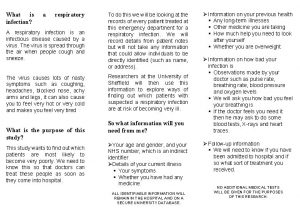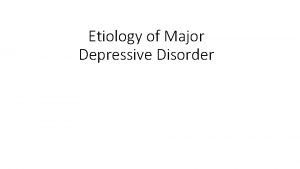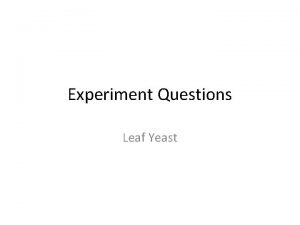RESPIRATORY FUNGAL INFECTION RESPIRATORY FUNGAL INFECTION Etiology YEAST












- Slides: 12

RESPIRATORY FUNGAL INFECTION

RESPIRATORY FUNGAL INFECTION Etiology YEAST MOULD FUNGI EXAMPLES Opportunistic Candidiasis (Candida and other yeast) Cryptococcosis -Cryptococcus neoformans, -C. gattii DIMORPHIC FUNGI Primary Infectious Aspergillosis (Aspergillus species) Zygomycosis (Zygomycetes, e. g. Rhizopus, Mucor) Other Mould Histoplasma capsulatum Paracoccidioides brasiliensis Blastomyces dermatitidis Coccidioides immitis

PRIMARY SYSTEMIC MYCOSIS Infections of the respiratory system, (Inhalation ) Dissemination seen in immunocompromised hosts Common in North America and to a lesser extent in South America. Not common in other parts of the World. Found in: In nature found in soil of restricted habitats Highly Infectious, and they are primary pathogen. Dimorphic Fungi Histoplasmosis Blastomycosis Coccidioidomycosis Paracoccidioidomycosis

ASPERGILLOSIS Aspergillosis is a spectrum of diseases of humans and animals caused by members of the genus Aspergillus. These diseases include: Mycotoxicosis ü ü ü Mycotoxicosis Allergy Colonization (without invasion and extension ) in preformed cavities Invasive disease of lungs Systemic and disseminated disease. Risk Factors üTransplant Patients “e. g. bone marrow” üMalignancy “leukemia, lymphoma” üAIDS üDiabetes üAnd many others

CLASSIFICATION OF ASPERGILLOSIS Invasive Aspergillosis Signs: Cough , hemoptysis, fever, Leukocytosis Chronic Aspergillosis Aspergilloma OR Aspergillus fungus ball Signs include: Cough, hemoptysis, variable fever Radiology will show lesions with halo sign Allergic Aspergillosis Radiology will show mass in the lung , radiolucent crescent Allergic bronchopulmonary (ABPA) Allergic Aspergillus sinusitis Single Aspergilloma

ASPERGILLOSIS Etiology: Aspergillus species, common species are: ü A. fumigatus “ Invasive” ü A. flavus, “Allergic”” ü A. niger üA. terreus and üA. nidulans Treatment Antifungal: Voriconazole “Drug of choice” Alternative therapy: Amphotericin B, Itraconazole, Caspofungin Diagnosis Aspergillus niger -Speciemen: ü Respiratory specimens: Sputum, BAL, Lung biopsy, Other samples: Blood -Microscopiy: Giemsa Stain, Grecott methenamine silver stain (GMS) Will show fungal septate hyphae -Culture: on SDA -Serology: Test for Antibody , ELISA test for galactomannan Antigen -PCR: Detection of Aspergillus DNA in clinical samples Aspergillus fumigatus

ALLERGIC BRONCHO-PULMONARY ASPERGILLOSIS Clinical Features: “Symptoms of Asthma” ü Bronchial obstruction ü Fever, malaise ü Eosinophilia ü Wheezing +/- Also: ü Skin test reactivity to Aspergillus ü Serum antibodies to Aspergillus ü Serum Ig. E > 1000 ng/ml ü Pulmonary infiltrates

FUNGAL SIINUSITIS Clinical Features: Ø Nasal polyps – and other symptoms of sinusitis Ø In immunocompromised, Could disseminate to – eye craneum (Rhinocerebral) Ø Aspergillus sinusitis has the same spectrum of Aspergillus disease in the lung Etiology: Treatment Common in KSA is Aspergillus flavus Depends on the type and severity of the disease and the immunological status of the patient “In addition to Aspergillus, there are other fungi that can cause fungal sinusitis” Diagnosis -Clinical and Radiology -Histology -Culture -Precipitating antibodies useful in diagnosis -Measurement of Ig. E level, RAST test

Zygomycosis Pulmonary Zygomycosis Rhinocerebral Zygomycosis Risk Factors üTransplant Patients üMalignancy üAIDS üDiabetic Ketoacidosis üAnd many others

PULMONARY ZYGOMYCOSIS Acute disease Features include: Consolidation, Nodules, pleural effusion, hemoptysis Infection may extend to chest wall, diaphragm and pericardium causing: ü Pulmonary Infarctions and hemorrhage ü Rapid evolving clinical course Etiology: Zygomycetes , Non-septate hyphae. e. g. Rhizopus Treatment ü Amphotericin B ü Surgery Diagnosis -Speciemen: Respiratory specimens: Sputum, BAL, Lung biopsy, -Microscopiy: Giemsa, Grecott methenamine silver stain (GMS) Will show broad non- septate fungal -Culture: on SDA “No cycloheximide”

PNEUMOCYSTOSIS “PNEUMOCYSTIS PNEUMONIA” It’s interstitial pneumonia of alveolar area Affect immuno-compromised patients, especially AIDS patient. Etiology: Pneumocystis jiroveci “Previously thought to be protozoan parasite, but later has proven to be a fungus” ü Treatment - Trimethoprim-sulfamethoxazole ü - Dapsone Diagnosis -Speciemen: Bronchoscopic specimens (B. A. L. ), Sputum, Lung biopsy tissue. -Histological sections or smears stained by GMS stain -Immunofluorescence have better sensitivty, positive result will show cysts of hat-shape, cup shape, crescent Found In rodents (rats), other animals (goats, horses), Humans may contract it during childhood

Good Luck DONE BY MICROBIOLOGY TEAM CONTACT US: MICROBIOLOGY 434@GMAIL. COM
 Walgreens spermicide
Walgreens spermicide Methotrexate and yeast infections
Methotrexate and yeast infections Protective reflexes
Protective reflexes Conclusion of respiratory tract infection
Conclusion of respiratory tract infection Classification of upper respiratory tract infection
Classification of upper respiratory tract infection Etiology synonym
Etiology synonym Oligohydramnios management
Oligohydramnios management Etiological models of addiction
Etiological models of addiction Bronchopneumonia
Bronchopneumonia Rampant caries معنى
Rampant caries معنى Etiology
Etiology Tccdtccd
Tccdtccd Asthma grades
Asthma grades
